Industry Analysis: Economics Assignment - University Name
VerifiedAdded on 2022/09/28
|12
|2808
|52
Homework Assignment
AI Summary
This document provides a comprehensive solution to an economics assignment focusing on industry analysis. The assignment addresses key economic concepts such as economies of scale and scope within the automobile industry, analyzing its market structure as an oligopoly and its long-run equilibrium. It further explores market entry decisions using a scenario with three markets, calculating expected unit sales and profit. Additionally, the solution delves into the phenomena of hidden action and hidden information, discussing moral hazard in the context of the insurance sector. Finally, it examines incentive conflicts between stakeholders like company managers and shareholders, as well as within team structures, proposing solutions to mitigate these conflicts and enhance efficiency. The solution is well-structured, providing detailed answers to all the questions posed in the assignment brief.
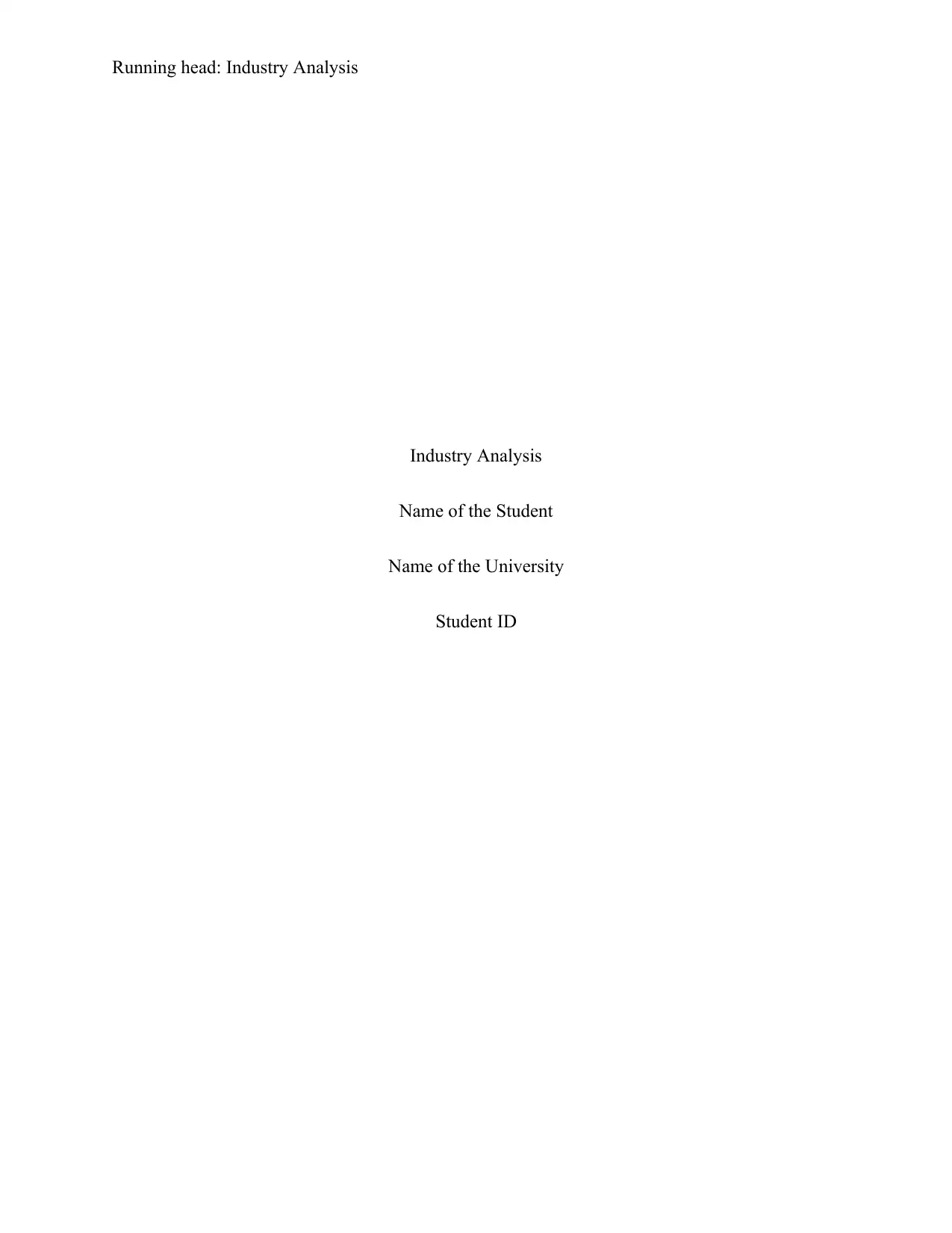
Running head: Industry Analysis
Industry Analysis
Name of the Student
Name of the University
Student ID
Industry Analysis
Name of the Student
Name of the University
Student ID
Paraphrase This Document
Need a fresh take? Get an instant paraphrase of this document with our AI Paraphraser
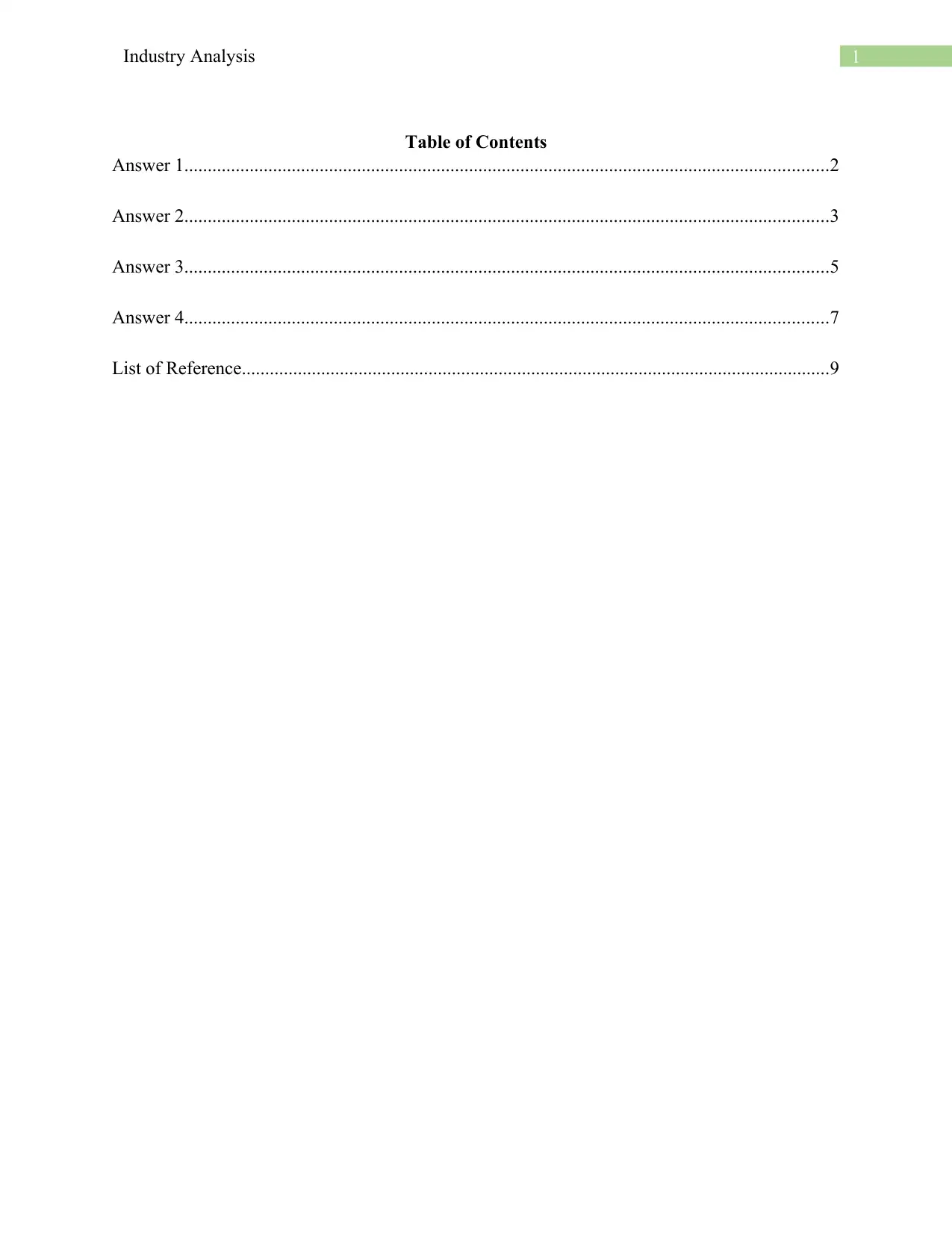
1Industry Analysis
Table of Contents
Answer 1..........................................................................................................................................2
Answer 2..........................................................................................................................................3
Answer 3..........................................................................................................................................5
Answer 4..........................................................................................................................................7
List of Reference..............................................................................................................................9
Table of Contents
Answer 1..........................................................................................................................................2
Answer 2..........................................................................................................................................3
Answer 3..........................................................................................................................................5
Answer 4..........................................................................................................................................7
List of Reference..............................................................................................................................9
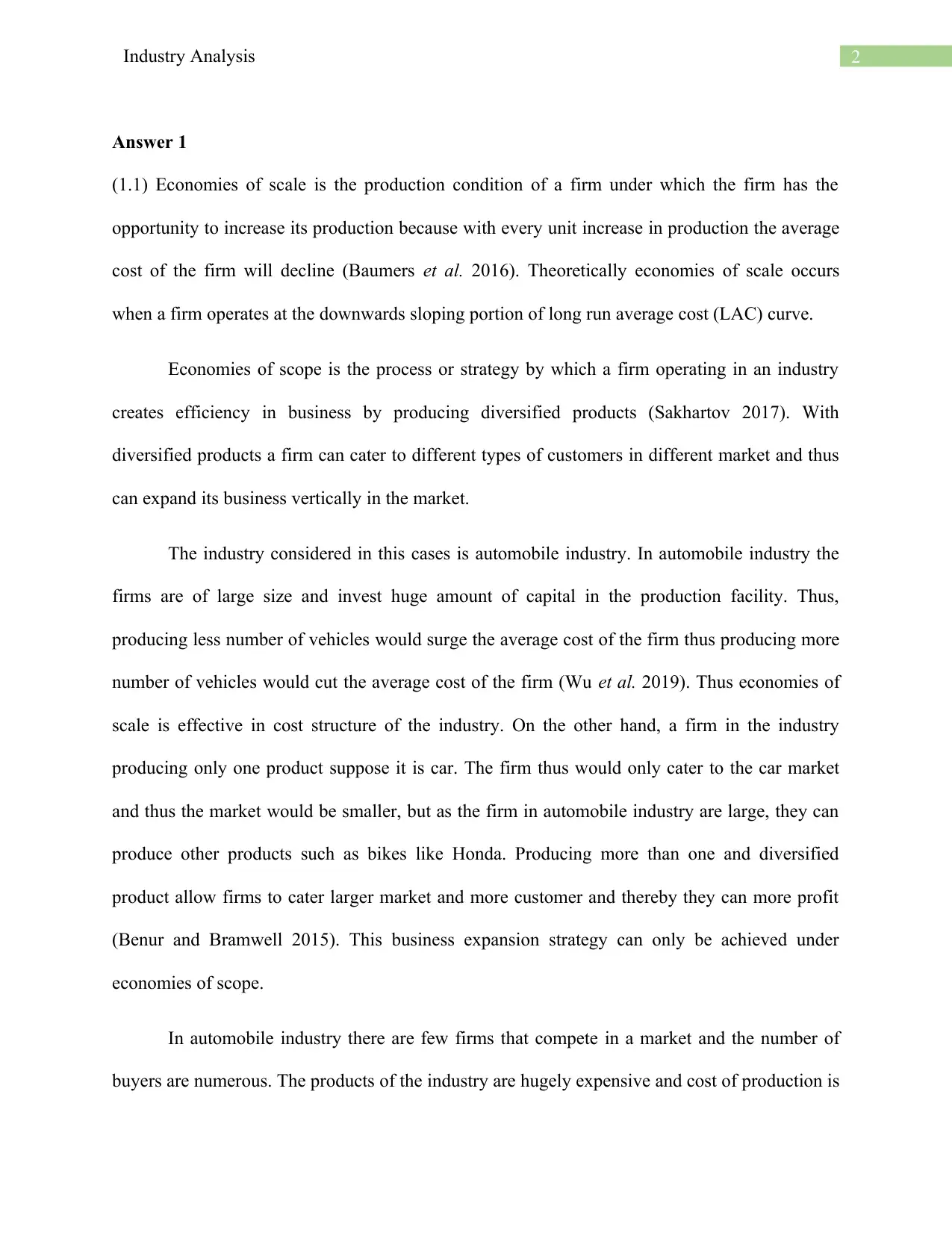
2Industry Analysis
Answer 1
(1.1) Economies of scale is the production condition of a firm under which the firm has the
opportunity to increase its production because with every unit increase in production the average
cost of the firm will decline (Baumers et al. 2016). Theoretically economies of scale occurs
when a firm operates at the downwards sloping portion of long run average cost (LAC) curve.
Economies of scope is the process or strategy by which a firm operating in an industry
creates efficiency in business by producing diversified products (Sakhartov 2017). With
diversified products a firm can cater to different types of customers in different market and thus
can expand its business vertically in the market.
The industry considered in this cases is automobile industry. In automobile industry the
firms are of large size and invest huge amount of capital in the production facility. Thus,
producing less number of vehicles would surge the average cost of the firm thus producing more
number of vehicles would cut the average cost of the firm (Wu et al. 2019). Thus economies of
scale is effective in cost structure of the industry. On the other hand, a firm in the industry
producing only one product suppose it is car. The firm thus would only cater to the car market
and thus the market would be smaller, but as the firm in automobile industry are large, they can
produce other products such as bikes like Honda. Producing more than one and diversified
product allow firms to cater larger market and more customer and thereby they can more profit
(Benur and Bramwell 2015). This business expansion strategy can only be achieved under
economies of scope.
In automobile industry there are few firms that compete in a market and the number of
buyers are numerous. The products of the industry are hugely expensive and cost of production is
Answer 1
(1.1) Economies of scale is the production condition of a firm under which the firm has the
opportunity to increase its production because with every unit increase in production the average
cost of the firm will decline (Baumers et al. 2016). Theoretically economies of scale occurs
when a firm operates at the downwards sloping portion of long run average cost (LAC) curve.
Economies of scope is the process or strategy by which a firm operating in an industry
creates efficiency in business by producing diversified products (Sakhartov 2017). With
diversified products a firm can cater to different types of customers in different market and thus
can expand its business vertically in the market.
The industry considered in this cases is automobile industry. In automobile industry the
firms are of large size and invest huge amount of capital in the production facility. Thus,
producing less number of vehicles would surge the average cost of the firm thus producing more
number of vehicles would cut the average cost of the firm (Wu et al. 2019). Thus economies of
scale is effective in cost structure of the industry. On the other hand, a firm in the industry
producing only one product suppose it is car. The firm thus would only cater to the car market
and thus the market would be smaller, but as the firm in automobile industry are large, they can
produce other products such as bikes like Honda. Producing more than one and diversified
product allow firms to cater larger market and more customer and thereby they can more profit
(Benur and Bramwell 2015). This business expansion strategy can only be achieved under
economies of scope.
In automobile industry there are few firms that compete in a market and the number of
buyers are numerous. The products of the industry are hugely expensive and cost of production is
⊘ This is a preview!⊘
Do you want full access?
Subscribe today to unlock all pages.

Trusted by 1+ million students worldwide
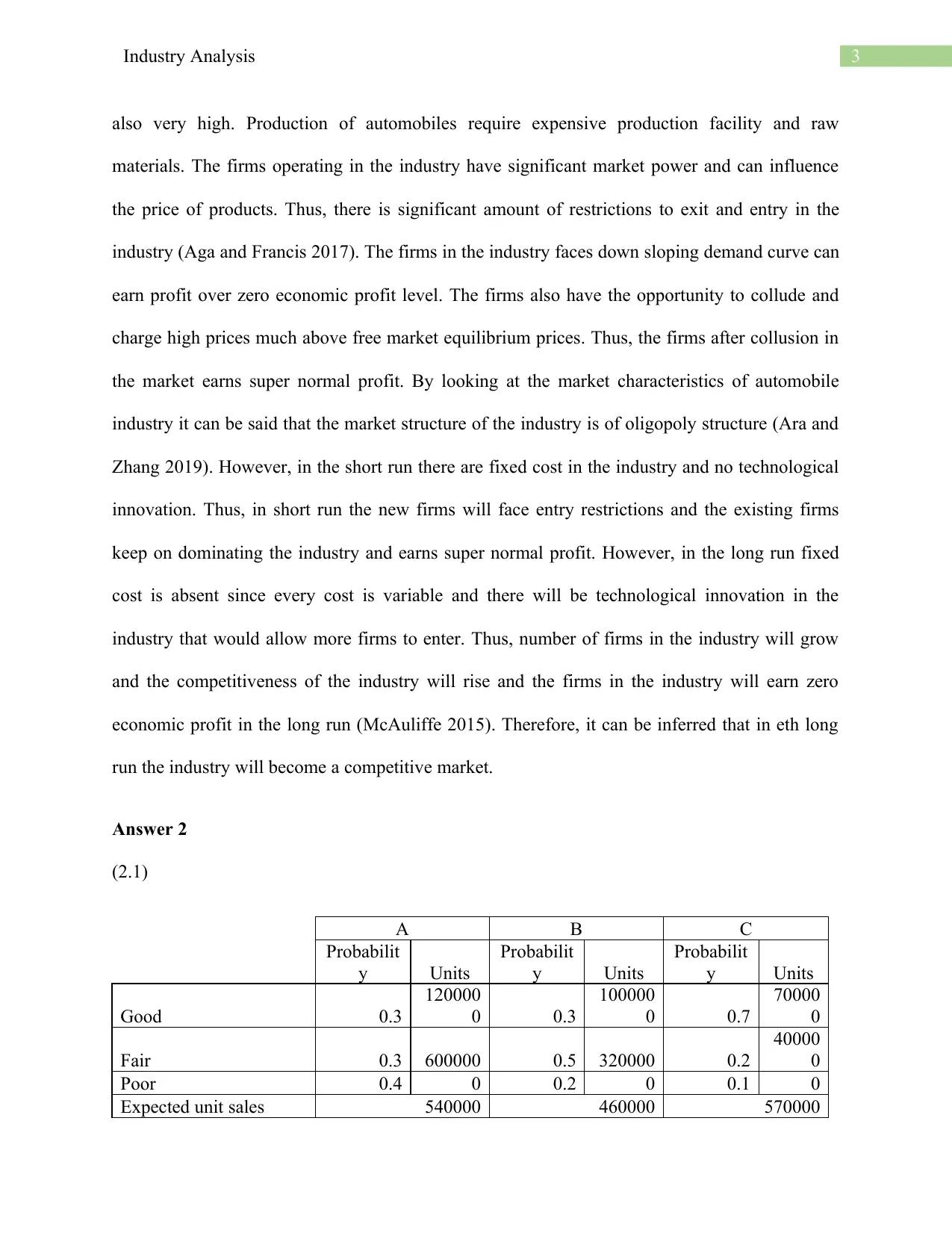
3Industry Analysis
also very high. Production of automobiles require expensive production facility and raw
materials. The firms operating in the industry have significant market power and can influence
the price of products. Thus, there is significant amount of restrictions to exit and entry in the
industry (Aga and Francis 2017). The firms in the industry faces down sloping demand curve can
earn profit over zero economic profit level. The firms also have the opportunity to collude and
charge high prices much above free market equilibrium prices. Thus, the firms after collusion in
the market earns super normal profit. By looking at the market characteristics of automobile
industry it can be said that the market structure of the industry is of oligopoly structure (Ara and
Zhang 2019). However, in the short run there are fixed cost in the industry and no technological
innovation. Thus, in short run the new firms will face entry restrictions and the existing firms
keep on dominating the industry and earns super normal profit. However, in the long run fixed
cost is absent since every cost is variable and there will be technological innovation in the
industry that would allow more firms to enter. Thus, number of firms in the industry will grow
and the competitiveness of the industry will rise and the firms in the industry will earn zero
economic profit in the long run (McAuliffe 2015). Therefore, it can be inferred that in eth long
run the industry will become a competitive market.
Answer 2
(2.1)
A B C
Probabilit
y Units
Probabilit
y Units
Probabilit
y Units
Good 0.3
120000
0 0.3
100000
0 0.7
70000
0
Fair 0.3 600000 0.5 320000 0.2
40000
0
Poor 0.4 0 0.2 0 0.1 0
Expected unit sales 540000 460000 570000
also very high. Production of automobiles require expensive production facility and raw
materials. The firms operating in the industry have significant market power and can influence
the price of products. Thus, there is significant amount of restrictions to exit and entry in the
industry (Aga and Francis 2017). The firms in the industry faces down sloping demand curve can
earn profit over zero economic profit level. The firms also have the opportunity to collude and
charge high prices much above free market equilibrium prices. Thus, the firms after collusion in
the market earns super normal profit. By looking at the market characteristics of automobile
industry it can be said that the market structure of the industry is of oligopoly structure (Ara and
Zhang 2019). However, in the short run there are fixed cost in the industry and no technological
innovation. Thus, in short run the new firms will face entry restrictions and the existing firms
keep on dominating the industry and earns super normal profit. However, in the long run fixed
cost is absent since every cost is variable and there will be technological innovation in the
industry that would allow more firms to enter. Thus, number of firms in the industry will grow
and the competitiveness of the industry will rise and the firms in the industry will earn zero
economic profit in the long run (McAuliffe 2015). Therefore, it can be inferred that in eth long
run the industry will become a competitive market.
Answer 2
(2.1)
A B C
Probabilit
y Units
Probabilit
y Units
Probabilit
y Units
Good 0.3
120000
0 0.3
100000
0 0.7
70000
0
Fair 0.3 600000 0.5 320000 0.2
40000
0
Poor 0.4 0 0.2 0 0.1 0
Expected unit sales 540000 460000 570000
Paraphrase This Document
Need a fresh take? Get an instant paraphrase of this document with our AI Paraphraser
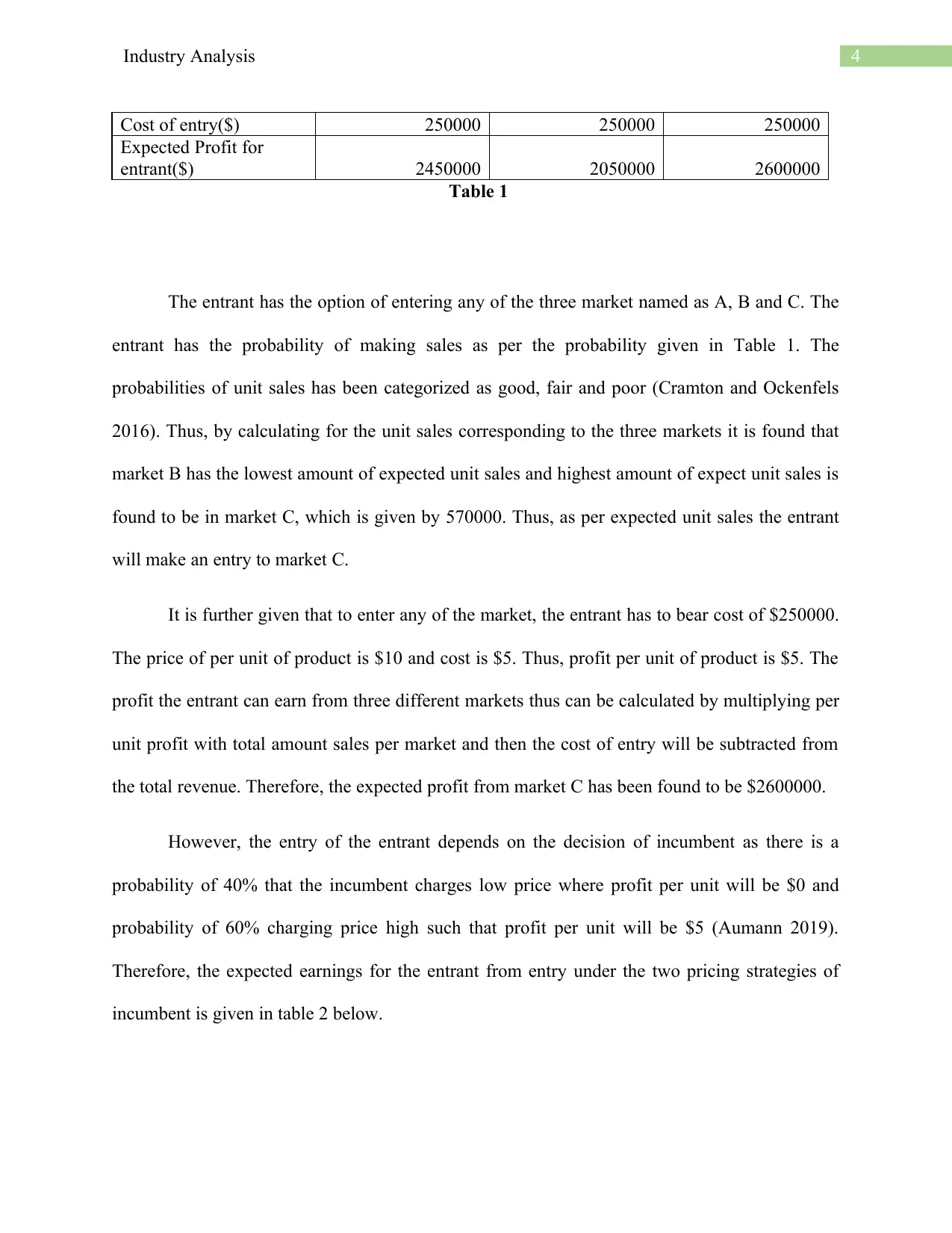
4Industry Analysis
Cost of entry($) 250000 250000 250000
Expected Profit for
entrant($) 2450000 2050000 2600000
Table 1
The entrant has the option of entering any of the three market named as A, B and C. The
entrant has the probability of making sales as per the probability given in Table 1. The
probabilities of unit sales has been categorized as good, fair and poor (Cramton and Ockenfels
2016). Thus, by calculating for the unit sales corresponding to the three markets it is found that
market B has the lowest amount of expected unit sales and highest amount of expect unit sales is
found to be in market C, which is given by 570000. Thus, as per expected unit sales the entrant
will make an entry to market C.
It is further given that to enter any of the market, the entrant has to bear cost of $250000.
The price of per unit of product is $10 and cost is $5. Thus, profit per unit of product is $5. The
profit the entrant can earn from three different markets thus can be calculated by multiplying per
unit profit with total amount sales per market and then the cost of entry will be subtracted from
the total revenue. Therefore, the expected profit from market C has been found to be $2600000.
However, the entry of the entrant depends on the decision of incumbent as there is a
probability of 40% that the incumbent charges low price where profit per unit will be $0 and
probability of 60% charging price high such that profit per unit will be $5 (Aumann 2019).
Therefore, the expected earnings for the entrant from entry under the two pricing strategies of
incumbent is given in table 2 below.
Cost of entry($) 250000 250000 250000
Expected Profit for
entrant($) 2450000 2050000 2600000
Table 1
The entrant has the option of entering any of the three market named as A, B and C. The
entrant has the probability of making sales as per the probability given in Table 1. The
probabilities of unit sales has been categorized as good, fair and poor (Cramton and Ockenfels
2016). Thus, by calculating for the unit sales corresponding to the three markets it is found that
market B has the lowest amount of expected unit sales and highest amount of expect unit sales is
found to be in market C, which is given by 570000. Thus, as per expected unit sales the entrant
will make an entry to market C.
It is further given that to enter any of the market, the entrant has to bear cost of $250000.
The price of per unit of product is $10 and cost is $5. Thus, profit per unit of product is $5. The
profit the entrant can earn from three different markets thus can be calculated by multiplying per
unit profit with total amount sales per market and then the cost of entry will be subtracted from
the total revenue. Therefore, the expected profit from market C has been found to be $2600000.
However, the entry of the entrant depends on the decision of incumbent as there is a
probability of 40% that the incumbent charges low price where profit per unit will be $0 and
probability of 60% charging price high such that profit per unit will be $5 (Aumann 2019).
Therefore, the expected earnings for the entrant from entry under the two pricing strategies of
incumbent is given in table 2 below.
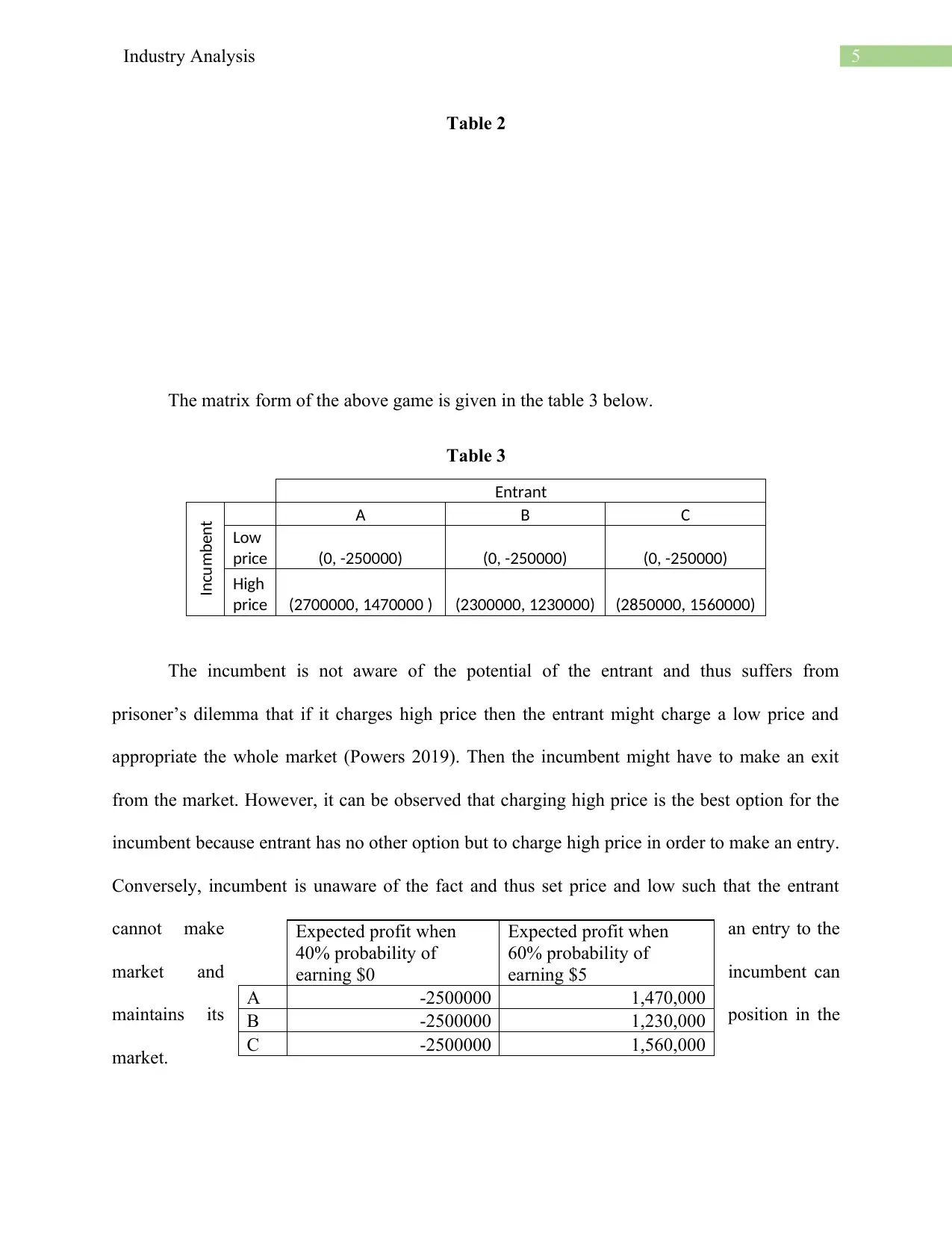
5Industry Analysis
Table 2
The matrix form of the above game is given in the table 3 below.
Table 3
The incumbent is not aware of the potential of the entrant and thus suffers from
prisoner’s dilemma that if it charges high price then the entrant might charge a low price and
appropriate the whole market (Powers 2019). Then the incumbent might have to make an exit
from the market. However, it can be observed that charging high price is the best option for the
incumbent because entrant has no other option but to charge high price in order to make an entry.
Conversely, incumbent is unaware of the fact and thus set price and low such that the entrant
cannot make an entry to the
market and incumbent can
maintains its position in the
market.
Expected profit when
40% probability of
earning $0
Expected profit when
60% probability of
earning $5
A -2500000 1,470,000
B -2500000 1,230,000
C -2500000 1,560,000
Entrant
Incumbent A B C
Low
price (0, -250000) (0, -250000) (0, -250000)
High
price (2700000, 1470000 ) (2300000, 1230000) (2850000, 1560000)
Table 2
The matrix form of the above game is given in the table 3 below.
Table 3
The incumbent is not aware of the potential of the entrant and thus suffers from
prisoner’s dilemma that if it charges high price then the entrant might charge a low price and
appropriate the whole market (Powers 2019). Then the incumbent might have to make an exit
from the market. However, it can be observed that charging high price is the best option for the
incumbent because entrant has no other option but to charge high price in order to make an entry.
Conversely, incumbent is unaware of the fact and thus set price and low such that the entrant
cannot make an entry to the
market and incumbent can
maintains its position in the
market.
Expected profit when
40% probability of
earning $0
Expected profit when
60% probability of
earning $5
A -2500000 1,470,000
B -2500000 1,230,000
C -2500000 1,560,000
Entrant
Incumbent A B C
Low
price (0, -250000) (0, -250000) (0, -250000)
High
price (2700000, 1470000 ) (2300000, 1230000) (2850000, 1560000)
⊘ This is a preview!⊘
Do you want full access?
Subscribe today to unlock all pages.

Trusted by 1+ million students worldwide
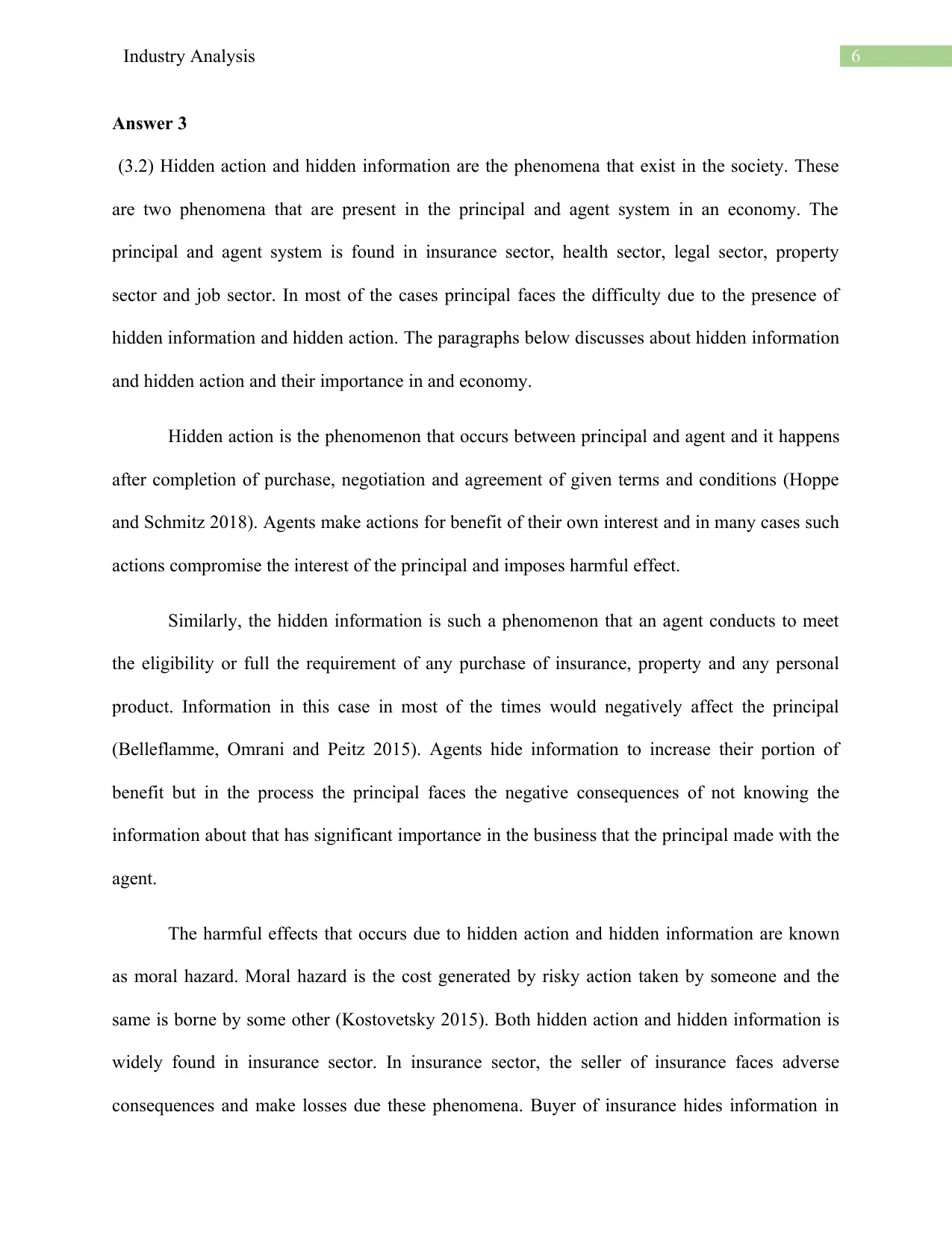
6Industry Analysis
Answer 3
(3.2) Hidden action and hidden information are the phenomena that exist in the society. These
are two phenomena that are present in the principal and agent system in an economy. The
principal and agent system is found in insurance sector, health sector, legal sector, property
sector and job sector. In most of the cases principal faces the difficulty due to the presence of
hidden information and hidden action. The paragraphs below discusses about hidden information
and hidden action and their importance in and economy.
Hidden action is the phenomenon that occurs between principal and agent and it happens
after completion of purchase, negotiation and agreement of given terms and conditions (Hoppe
and Schmitz 2018). Agents make actions for benefit of their own interest and in many cases such
actions compromise the interest of the principal and imposes harmful effect.
Similarly, the hidden information is such a phenomenon that an agent conducts to meet
the eligibility or full the requirement of any purchase of insurance, property and any personal
product. Information in this case in most of the times would negatively affect the principal
(Belleflamme, Omrani and Peitz 2015). Agents hide information to increase their portion of
benefit but in the process the principal faces the negative consequences of not knowing the
information about that has significant importance in the business that the principal made with the
agent.
The harmful effects that occurs due to hidden action and hidden information are known
as moral hazard. Moral hazard is the cost generated by risky action taken by someone and the
same is borne by some other (Kostovetsky 2015). Both hidden action and hidden information is
widely found in insurance sector. In insurance sector, the seller of insurance faces adverse
consequences and make losses due these phenomena. Buyer of insurance hides information in
Answer 3
(3.2) Hidden action and hidden information are the phenomena that exist in the society. These
are two phenomena that are present in the principal and agent system in an economy. The
principal and agent system is found in insurance sector, health sector, legal sector, property
sector and job sector. In most of the cases principal faces the difficulty due to the presence of
hidden information and hidden action. The paragraphs below discusses about hidden information
and hidden action and their importance in and economy.
Hidden action is the phenomenon that occurs between principal and agent and it happens
after completion of purchase, negotiation and agreement of given terms and conditions (Hoppe
and Schmitz 2018). Agents make actions for benefit of their own interest and in many cases such
actions compromise the interest of the principal and imposes harmful effect.
Similarly, the hidden information is such a phenomenon that an agent conducts to meet
the eligibility or full the requirement of any purchase of insurance, property and any personal
product. Information in this case in most of the times would negatively affect the principal
(Belleflamme, Omrani and Peitz 2015). Agents hide information to increase their portion of
benefit but in the process the principal faces the negative consequences of not knowing the
information about that has significant importance in the business that the principal made with the
agent.
The harmful effects that occurs due to hidden action and hidden information are known
as moral hazard. Moral hazard is the cost generated by risky action taken by someone and the
same is borne by some other (Kostovetsky 2015). Both hidden action and hidden information is
widely found in insurance sector. In insurance sector, the seller of insurance faces adverse
consequences and make losses due these phenomena. Buyer of insurance hides information in
Paraphrase This Document
Need a fresh take? Get an instant paraphrase of this document with our AI Paraphraser
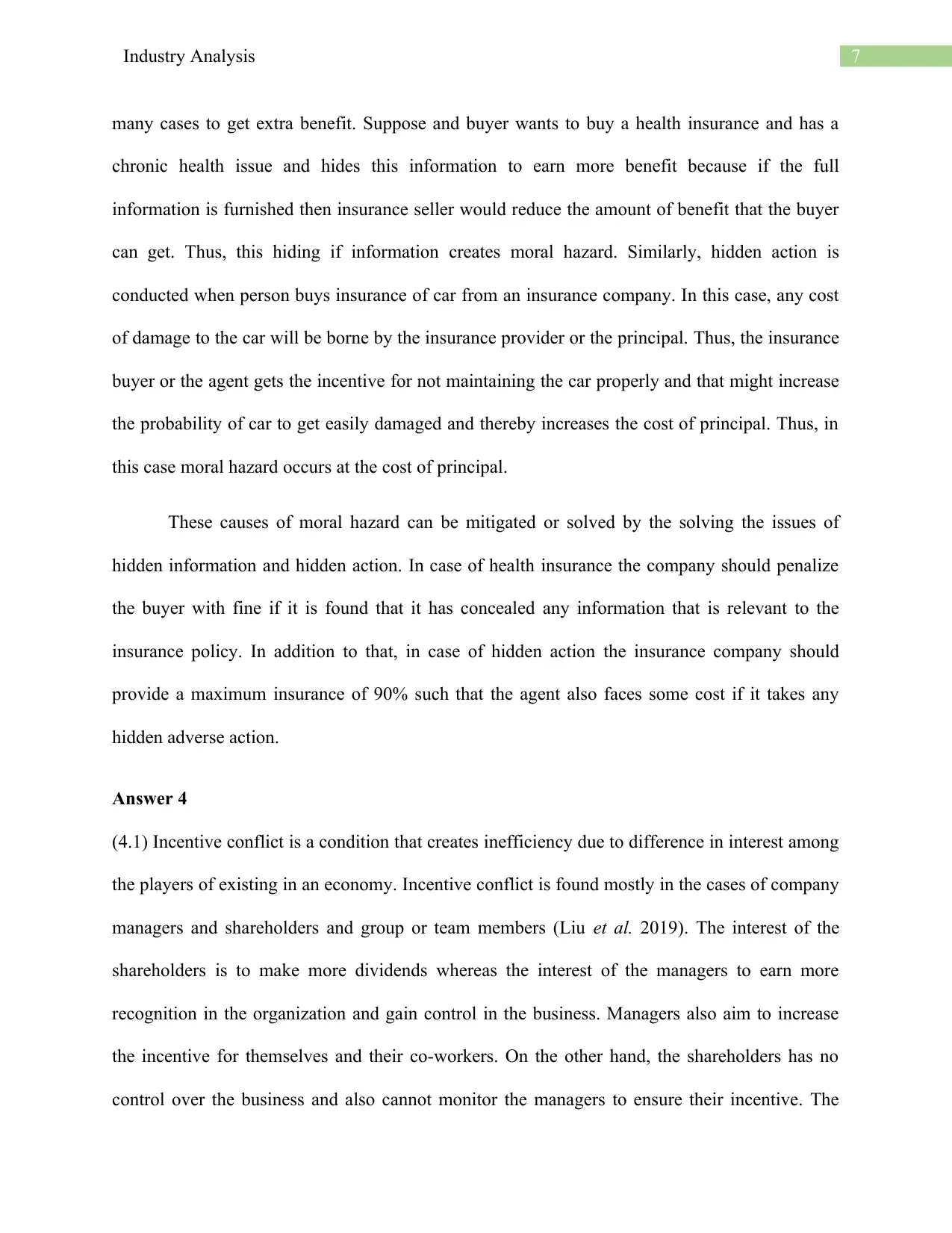
7Industry Analysis
many cases to get extra benefit. Suppose and buyer wants to buy a health insurance and has a
chronic health issue and hides this information to earn more benefit because if the full
information is furnished then insurance seller would reduce the amount of benefit that the buyer
can get. Thus, this hiding if information creates moral hazard. Similarly, hidden action is
conducted when person buys insurance of car from an insurance company. In this case, any cost
of damage to the car will be borne by the insurance provider or the principal. Thus, the insurance
buyer or the agent gets the incentive for not maintaining the car properly and that might increase
the probability of car to get easily damaged and thereby increases the cost of principal. Thus, in
this case moral hazard occurs at the cost of principal.
These causes of moral hazard can be mitigated or solved by the solving the issues of
hidden information and hidden action. In case of health insurance the company should penalize
the buyer with fine if it is found that it has concealed any information that is relevant to the
insurance policy. In addition to that, in case of hidden action the insurance company should
provide a maximum insurance of 90% such that the agent also faces some cost if it takes any
hidden adverse action.
Answer 4
(4.1) Incentive conflict is a condition that creates inefficiency due to difference in interest among
the players of existing in an economy. Incentive conflict is found mostly in the cases of company
managers and shareholders and group or team members (Liu et al. 2019). The interest of the
shareholders is to make more dividends whereas the interest of the managers to earn more
recognition in the organization and gain control in the business. Managers also aim to increase
the incentive for themselves and their co-workers. On the other hand, the shareholders has no
control over the business and also cannot monitor the managers to ensure their incentive. The
many cases to get extra benefit. Suppose and buyer wants to buy a health insurance and has a
chronic health issue and hides this information to earn more benefit because if the full
information is furnished then insurance seller would reduce the amount of benefit that the buyer
can get. Thus, this hiding if information creates moral hazard. Similarly, hidden action is
conducted when person buys insurance of car from an insurance company. In this case, any cost
of damage to the car will be borne by the insurance provider or the principal. Thus, the insurance
buyer or the agent gets the incentive for not maintaining the car properly and that might increase
the probability of car to get easily damaged and thereby increases the cost of principal. Thus, in
this case moral hazard occurs at the cost of principal.
These causes of moral hazard can be mitigated or solved by the solving the issues of
hidden information and hidden action. In case of health insurance the company should penalize
the buyer with fine if it is found that it has concealed any information that is relevant to the
insurance policy. In addition to that, in case of hidden action the insurance company should
provide a maximum insurance of 90% such that the agent also faces some cost if it takes any
hidden adverse action.
Answer 4
(4.1) Incentive conflict is a condition that creates inefficiency due to difference in interest among
the players of existing in an economy. Incentive conflict is found mostly in the cases of company
managers and shareholders and group or team members (Liu et al. 2019). The interest of the
shareholders is to make more dividends whereas the interest of the managers to earn more
recognition in the organization and gain control in the business. Managers also aim to increase
the incentive for themselves and their co-workers. On the other hand, the shareholders has no
control over the business and also cannot monitor the managers to ensure their incentive. The
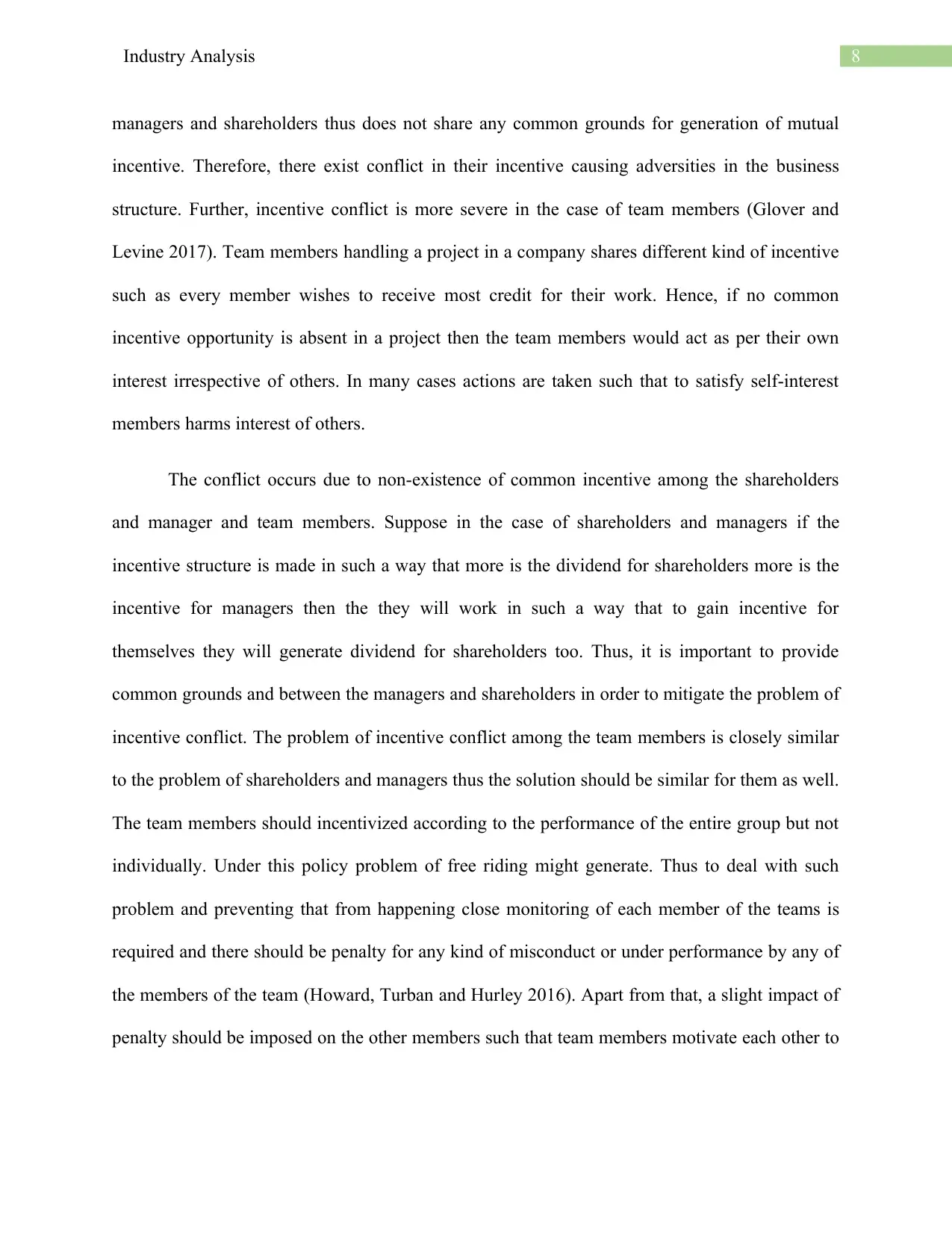
8Industry Analysis
managers and shareholders thus does not share any common grounds for generation of mutual
incentive. Therefore, there exist conflict in their incentive causing adversities in the business
structure. Further, incentive conflict is more severe in the case of team members (Glover and
Levine 2017). Team members handling a project in a company shares different kind of incentive
such as every member wishes to receive most credit for their work. Hence, if no common
incentive opportunity is absent in a project then the team members would act as per their own
interest irrespective of others. In many cases actions are taken such that to satisfy self-interest
members harms interest of others.
The conflict occurs due to non-existence of common incentive among the shareholders
and manager and team members. Suppose in the case of shareholders and managers if the
incentive structure is made in such a way that more is the dividend for shareholders more is the
incentive for managers then the they will work in such a way that to gain incentive for
themselves they will generate dividend for shareholders too. Thus, it is important to provide
common grounds and between the managers and shareholders in order to mitigate the problem of
incentive conflict. The problem of incentive conflict among the team members is closely similar
to the problem of shareholders and managers thus the solution should be similar for them as well.
The team members should incentivized according to the performance of the entire group but not
individually. Under this policy problem of free riding might generate. Thus to deal with such
problem and preventing that from happening close monitoring of each member of the teams is
required and there should be penalty for any kind of misconduct or under performance by any of
the members of the team (Howard, Turban and Hurley 2016). Apart from that, a slight impact of
penalty should be imposed on the other members such that team members motivate each other to
managers and shareholders thus does not share any common grounds for generation of mutual
incentive. Therefore, there exist conflict in their incentive causing adversities in the business
structure. Further, incentive conflict is more severe in the case of team members (Glover and
Levine 2017). Team members handling a project in a company shares different kind of incentive
such as every member wishes to receive most credit for their work. Hence, if no common
incentive opportunity is absent in a project then the team members would act as per their own
interest irrespective of others. In many cases actions are taken such that to satisfy self-interest
members harms interest of others.
The conflict occurs due to non-existence of common incentive among the shareholders
and manager and team members. Suppose in the case of shareholders and managers if the
incentive structure is made in such a way that more is the dividend for shareholders more is the
incentive for managers then the they will work in such a way that to gain incentive for
themselves they will generate dividend for shareholders too. Thus, it is important to provide
common grounds and between the managers and shareholders in order to mitigate the problem of
incentive conflict. The problem of incentive conflict among the team members is closely similar
to the problem of shareholders and managers thus the solution should be similar for them as well.
The team members should incentivized according to the performance of the entire group but not
individually. Under this policy problem of free riding might generate. Thus to deal with such
problem and preventing that from happening close monitoring of each member of the teams is
required and there should be penalty for any kind of misconduct or under performance by any of
the members of the team (Howard, Turban and Hurley 2016). Apart from that, a slight impact of
penalty should be imposed on the other members such that team members motivate each other to
⊘ This is a preview!⊘
Do you want full access?
Subscribe today to unlock all pages.

Trusted by 1+ million students worldwide
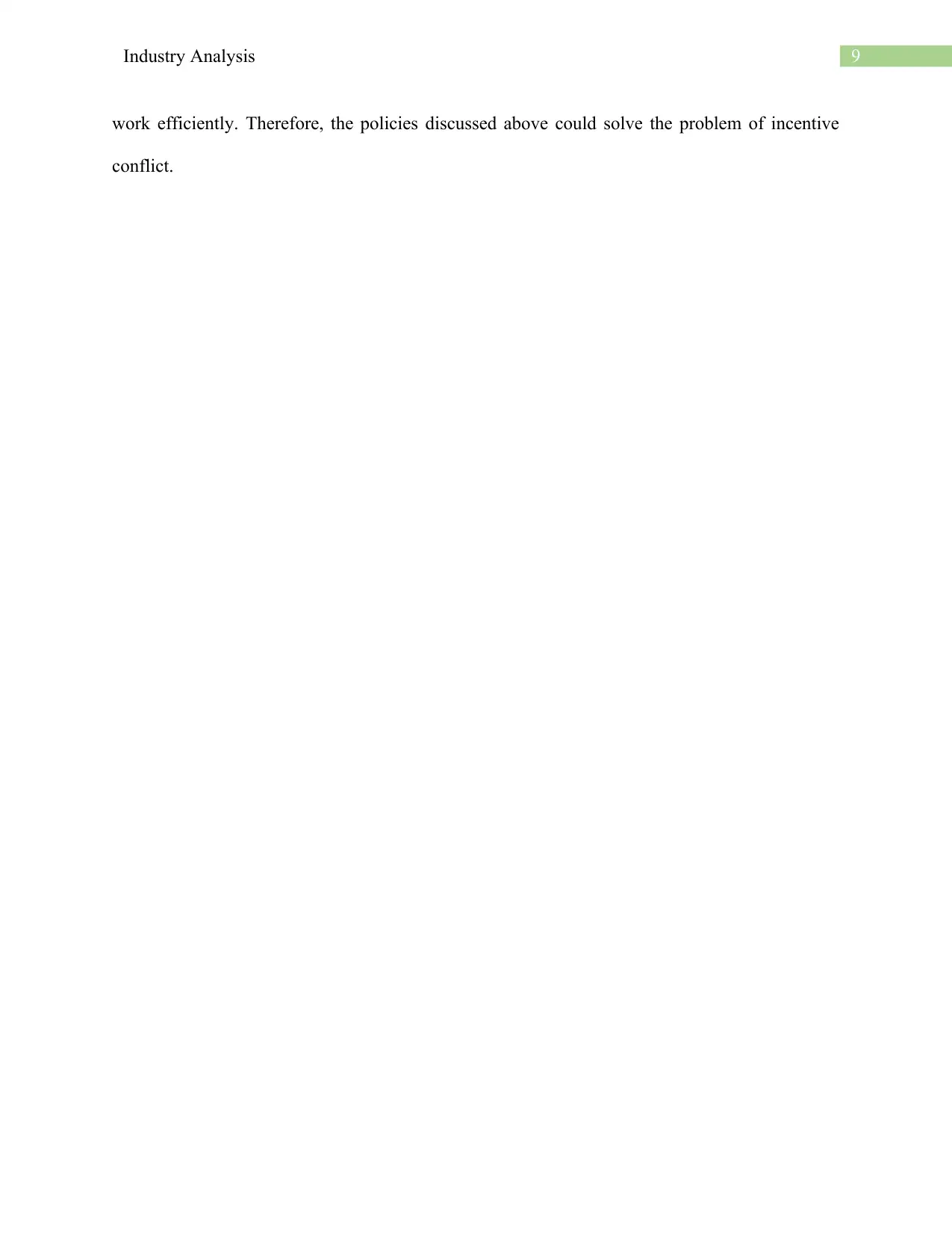
9Industry Analysis
work efficiently. Therefore, the policies discussed above could solve the problem of incentive
conflict.
work efficiently. Therefore, the policies discussed above could solve the problem of incentive
conflict.
Paraphrase This Document
Need a fresh take? Get an instant paraphrase of this document with our AI Paraphraser
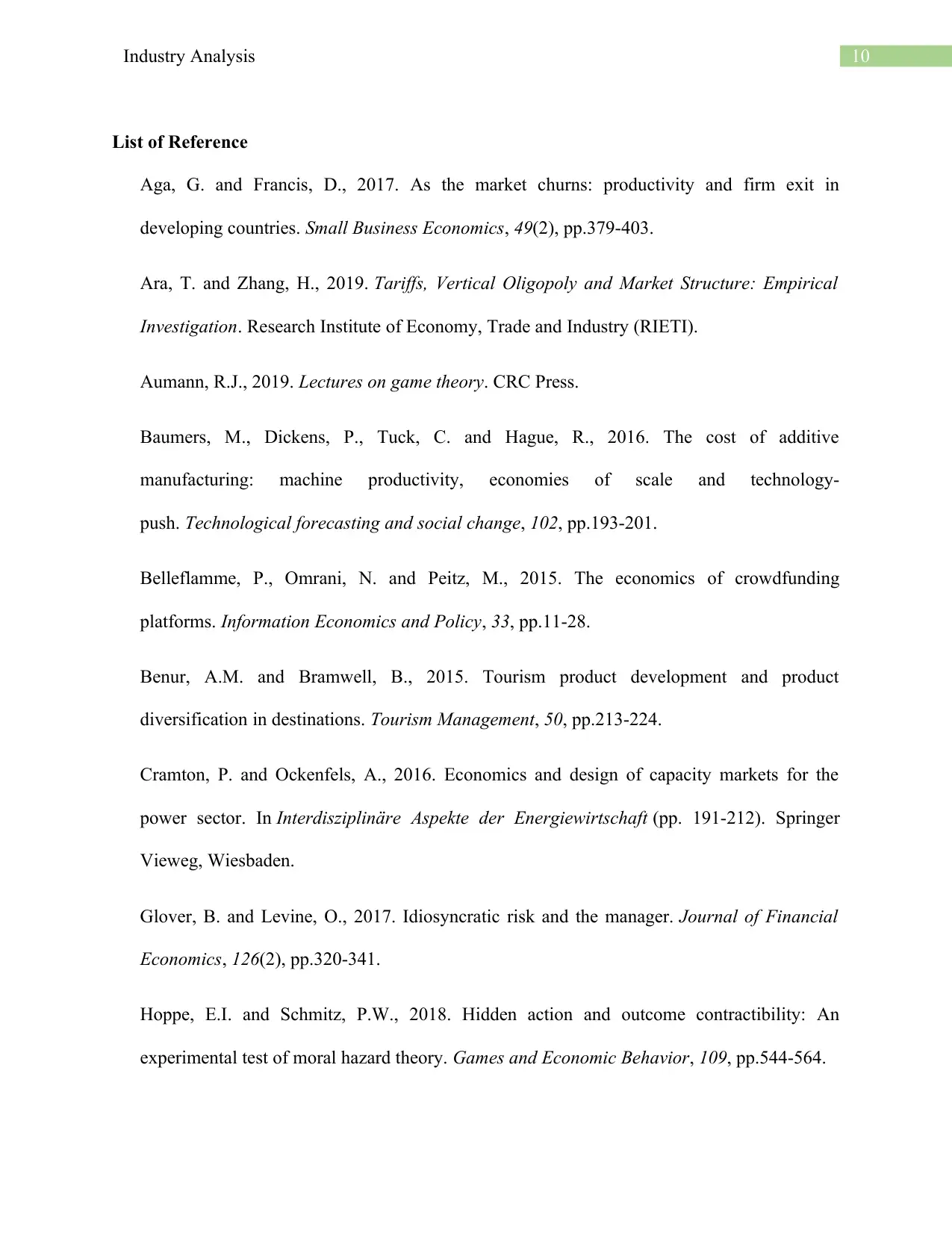
10Industry Analysis
List of Reference
Aga, G. and Francis, D., 2017. As the market churns: productivity and firm exit in
developing countries. Small Business Economics, 49(2), pp.379-403.
Ara, T. and Zhang, H., 2019. Tariffs, Vertical Oligopoly and Market Structure: Empirical
Investigation. Research Institute of Economy, Trade and Industry (RIETI).
Aumann, R.J., 2019. Lectures on game theory. CRC Press.
Baumers, M., Dickens, P., Tuck, C. and Hague, R., 2016. The cost of additive
manufacturing: machine productivity, economies of scale and technology-
push. Technological forecasting and social change, 102, pp.193-201.
Belleflamme, P., Omrani, N. and Peitz, M., 2015. The economics of crowdfunding
platforms. Information Economics and Policy, 33, pp.11-28.
Benur, A.M. and Bramwell, B., 2015. Tourism product development and product
diversification in destinations. Tourism Management, 50, pp.213-224.
Cramton, P. and Ockenfels, A., 2016. Economics and design of capacity markets for the
power sector. In Interdisziplinäre Aspekte der Energiewirtschaft (pp. 191-212). Springer
Vieweg, Wiesbaden.
Glover, B. and Levine, O., 2017. Idiosyncratic risk and the manager. Journal of Financial
Economics, 126(2), pp.320-341.
Hoppe, E.I. and Schmitz, P.W., 2018. Hidden action and outcome contractibility: An
experimental test of moral hazard theory. Games and Economic Behavior, 109, pp.544-564.
List of Reference
Aga, G. and Francis, D., 2017. As the market churns: productivity and firm exit in
developing countries. Small Business Economics, 49(2), pp.379-403.
Ara, T. and Zhang, H., 2019. Tariffs, Vertical Oligopoly and Market Structure: Empirical
Investigation. Research Institute of Economy, Trade and Industry (RIETI).
Aumann, R.J., 2019. Lectures on game theory. CRC Press.
Baumers, M., Dickens, P., Tuck, C. and Hague, R., 2016. The cost of additive
manufacturing: machine productivity, economies of scale and technology-
push. Technological forecasting and social change, 102, pp.193-201.
Belleflamme, P., Omrani, N. and Peitz, M., 2015. The economics of crowdfunding
platforms. Information Economics and Policy, 33, pp.11-28.
Benur, A.M. and Bramwell, B., 2015. Tourism product development and product
diversification in destinations. Tourism Management, 50, pp.213-224.
Cramton, P. and Ockenfels, A., 2016. Economics and design of capacity markets for the
power sector. In Interdisziplinäre Aspekte der Energiewirtschaft (pp. 191-212). Springer
Vieweg, Wiesbaden.
Glover, B. and Levine, O., 2017. Idiosyncratic risk and the manager. Journal of Financial
Economics, 126(2), pp.320-341.
Hoppe, E.I. and Schmitz, P.W., 2018. Hidden action and outcome contractibility: An
experimental test of moral hazard theory. Games and Economic Behavior, 109, pp.544-564.
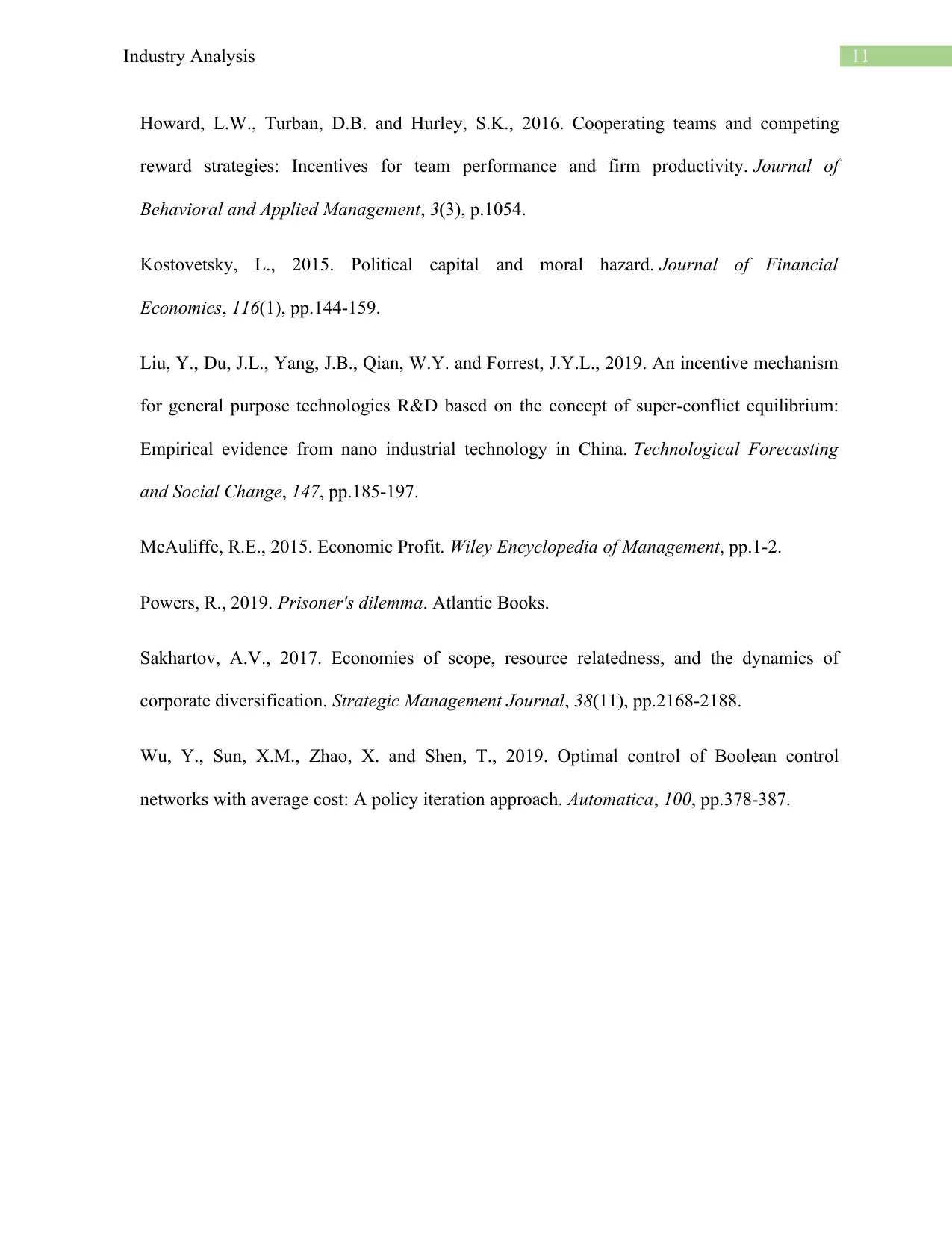
11Industry Analysis
Howard, L.W., Turban, D.B. and Hurley, S.K., 2016. Cooperating teams and competing
reward strategies: Incentives for team performance and firm productivity. Journal of
Behavioral and Applied Management, 3(3), p.1054.
Kostovetsky, L., 2015. Political capital and moral hazard. Journal of Financial
Economics, 116(1), pp.144-159.
Liu, Y., Du, J.L., Yang, J.B., Qian, W.Y. and Forrest, J.Y.L., 2019. An incentive mechanism
for general purpose technologies R&D based on the concept of super-conflict equilibrium:
Empirical evidence from nano industrial technology in China. Technological Forecasting
and Social Change, 147, pp.185-197.
McAuliffe, R.E., 2015. Economic Profit. Wiley Encyclopedia of Management, pp.1-2.
Powers, R., 2019. Prisoner's dilemma. Atlantic Books.
Sakhartov, A.V., 2017. Economies of scope, resource relatedness, and the dynamics of
corporate diversification. Strategic Management Journal, 38(11), pp.2168-2188.
Wu, Y., Sun, X.M., Zhao, X. and Shen, T., 2019. Optimal control of Boolean control
networks with average cost: A policy iteration approach. Automatica, 100, pp.378-387.
Howard, L.W., Turban, D.B. and Hurley, S.K., 2016. Cooperating teams and competing
reward strategies: Incentives for team performance and firm productivity. Journal of
Behavioral and Applied Management, 3(3), p.1054.
Kostovetsky, L., 2015. Political capital and moral hazard. Journal of Financial
Economics, 116(1), pp.144-159.
Liu, Y., Du, J.L., Yang, J.B., Qian, W.Y. and Forrest, J.Y.L., 2019. An incentive mechanism
for general purpose technologies R&D based on the concept of super-conflict equilibrium:
Empirical evidence from nano industrial technology in China. Technological Forecasting
and Social Change, 147, pp.185-197.
McAuliffe, R.E., 2015. Economic Profit. Wiley Encyclopedia of Management, pp.1-2.
Powers, R., 2019. Prisoner's dilemma. Atlantic Books.
Sakhartov, A.V., 2017. Economies of scope, resource relatedness, and the dynamics of
corporate diversification. Strategic Management Journal, 38(11), pp.2168-2188.
Wu, Y., Sun, X.M., Zhao, X. and Shen, T., 2019. Optimal control of Boolean control
networks with average cost: A policy iteration approach. Automatica, 100, pp.378-387.
⊘ This is a preview!⊘
Do you want full access?
Subscribe today to unlock all pages.

Trusted by 1+ million students worldwide
1 out of 12
Related Documents
Your All-in-One AI-Powered Toolkit for Academic Success.
+13062052269
info@desklib.com
Available 24*7 on WhatsApp / Email
![[object Object]](/_next/static/media/star-bottom.7253800d.svg)
Unlock your academic potential
Copyright © 2020–2025 A2Z Services. All Rights Reserved. Developed and managed by ZUCOL.





